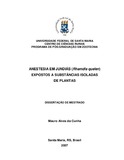| dc.creator | Cunha, Mauro Alves da | |
| dc.date.accessioned | 2013-04-24 | |
| dc.date.available | 2013-04-24 | |
| dc.date.issued | 2007-02-23 | |
| dc.identifier.citation | CUNHA, Mauro Alves da. Anesthesia in silver catfish (Rhamdia quelen) exposed to substances isolated from plants. 2007. 65 f. Dissertação (Mestrado em Zootecnia) - Universidade Federal de Santa Maria, Santa Maria, 2007. | por |
| dc.identifier.uri | http://repositorio.ufsm.br/handle/1/10807 | |
| dc.description.abstract | There are some effective anesthetics for fishes, but it is important to search
new alternatives of substances easily obtained, of low cost for fish farmers and with
no risk to fish and human health. Therefore, this study analyzed the use of some
substances extracted from plants as anesthetics, and if efective also evaluating their
effects on the stress of silver catfish (Rhamdia quelen). To identify time of induction
and anesthetic recovery, silver catfish juveniles were placed in aquaria containing
different concentrations of clove oil (Eugenol), essential oils extracted from plants:
Chenopodium ambrosioide, Eucalyptus citricola, Calea clematidea, Schinus
terebentifolius, Schinus lentiscifolius and Lithraea brasiliensis or extracts obtained
from Condalia buxifolia. After induction, fish were transferred to anesthetic-free
aquaria to evaluate recovery time. To determine the levels of plasma cortisol,
juveniles were exposed to 50mg/L of clove oil or 4mg/L of C. buxifolia methanolic
extract and exposed to air for 1 min. Blood was collected 0, 1 and 4 h air exposure
and some epecimens were killed at time 0h for sensorial evaluation of the fillet. The
results obtained showed that clove oil is a safe alternative as an anesthetic to silver
catfish at concentration of 50mg/L, as it reduces plasma cortisol when the fish is
exposed to air. However, it leaves a slightly unpleasant taste in the fillet. The C.
buxifolia methanolic extract can be used to sedate silver catfish, but it did not induce
anesthesia either decrease stress during handling, as it did not alter cortisol levels
compared to controls. Other tested substances did not demonstrate any anesthetic
effect. | eng |
| dc.description.sponsorship | Coordenação de Aperfeiçoamento de Pessoal de Nível Superior | |
| dc.format | application/pdf | por |
| dc.language | por | por |
| dc.publisher | Universidade Federal de Santa Maria | por |
| dc.rights | Acesso Aberto | por |
| dc.subject | Rhamdia quelen | por |
| dc.subject | Anestesia | por |
| dc.subject | Cortisol | por |
| dc.subject | Estresse | por |
| dc.subject | Rhamdia quelen | eng |
| dc.subject | Anesthesia | eng |
| dc.subject | Cortisol | eng |
| dc.subject | Stress | eng |
| dc.title | Anestesia em jundiás (Rhamdia quelen) expostos a substâncias isoladas de plantas | por |
| dc.title.alternative | Anesthesia in silver catfish (Rhamdia quelen) exposed to substances isolated from plants | eng |
| dc.type | Dissertação | por |
| dc.description.resumo | Existem alguns anestésicos efetivos para peixes, mas é importante buscar
novas alternativas de substâncias de fácil aquisição e baixo custo aos piscicultores e
que não ofereçam aos animais e manipuladores riscos à saúde. Portanto, este
trabalho verificou a utilização de algumas substâncias extraídas de plantas como
agentes anestésicos, e se efetivos também avaliar seus efeitos sobre o estresse em
jundiás (Rhamdia quelen). Para identificar o tempo de indução e recuperação
anestésica foram utilizados juvenis de jundiá, os quais foram colocados em aquários
com 1 L de água contendo diferentes concentrações de óleo de cravo (Eugenol),
óleos essenciais extraídos das plantas: Chenopodium ambrosioide, Eucalyptus
citricola, Calea clematidea, Schinus terebentifolius, Schinus lentiscifolius e Lithraea
brasiliensis ou extratos de Condalia buxifolia. Após a indução, os peixes foram
transferidos para aquários livres de anestésicos para avaliar de jundiá foram
submetidos a 50 mg/L de óleo de cravo ou 4 mg/L de extrato metanólico de C.
buxifolia e expostos ao ar por 1 min. O sangue foi coletado 0, 1 e 4 h após a
exposição ao ar e alguns exemplares do tempo 0 h foram abatidos para testes de
avaliação sensorial do filé. Os resultados obtidos mostraram que o óleo de cravo é
uma alternativa segura como anestésico para o jundiá na concentração de 50mg/L,
pois reduz o cortisol plasmático no momento da exposição ao ar, mas deixa um
sabor levemente desagradável ao filé. O extrato metanólico de C. buxifolia pode ser
usado para sedação de jundiás, mas não chega a levar à anestesia e não minimiza
o estresse da manipulação, pois não altera os níveis de cortisol em relação aos
controles. Demais substâncias testadas não apresentaram efeito anestésico. | por |
| dc.contributor.advisor1 | Baldisserotto, Bernardo | |
| dc.contributor.advisor1Lattes | http://lattes.cnpq.br/1036046601275319 | por |
| dc.contributor.referee1 | Gomes, Levy de Carvalho | |
| dc.contributor.referee1Lattes | http://lattes.cnpq.br/3105720686893127 | por |
| dc.contributor.referee2 | Carregaro, Adriano Bonfim | |
| dc.contributor.referee2Lattes | http://lattes.cnpq.br/5041153897534751 | por |
| dc.creator.Lattes | http://lattes.cnpq.br/9745413680917763 | por |
| dc.publisher.country | BR | por |
| dc.publisher.department | Zootecnia | por |
| dc.publisher.initials | UFSM | por |
| dc.publisher.program | Programa de Pós-Graduação em Zootecnia | por |
| dc.subject.cnpq | CNPQ::CIENCIAS AGRARIAS::ZOOTECNIA | por |


